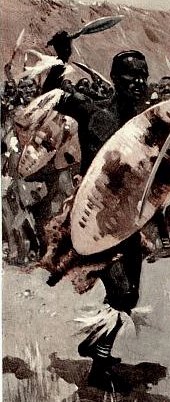
Impi is a Nguni word meaning war or combat and by association any body of men gathered for war, for example impi ya masosha is a term denoting an army. Impi were formed from regiments from amakhanda. In English impi is often used to refer to a Zulu regiment, which is called an ibutho in Zulu or the army.
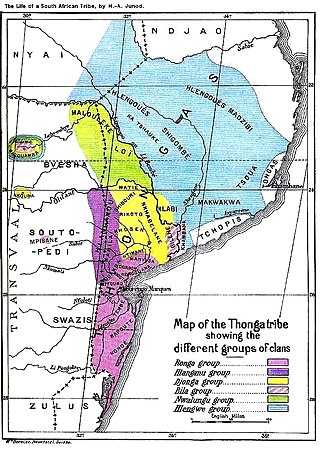
The Tsonga people are a Bantu ethnic group primarily native to Southern Mozambique and South Africa. They speak Xitsonga, a Southern Bantu language. A very small number of Tsonga people are also found in Zimbabwe and Northern Eswatini. The Tsonga people of South Africa share some history with the Tsonga people of Southern Mozambique, and have similar cultural practices, but differ in the dialects spoken.

Xai-Xai is a city in the south of Mozambique. Until 1975, the city was named João Belo. It is the capital of Gaza Province. As of 2007 it has a population of 116,343.

Ngungunyane, also known as Mdungazwe Ngungunyane Nxumalo, N'gungunhana, or Gungunhana Reinaldo Frederico Gungunhana, was a tribal king and vassal of the Portuguese Empire, who rebelled, was defeated by General Joaquim Mouzinho de Albuquerque and lived out the rest of his life in exile, first in Lisbon, but later on the island of Terceira, in the Azores.
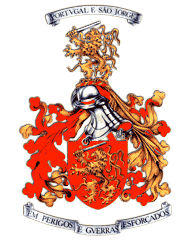
The Portuguese Army is the land component of the Armed Forces of Portugal and is also its largest branch. It is charged with the defence of Portugal, in co-operation with other branches of the Armed Forces. With its origins going back to the 12th century, it can be considered one of the oldest active armies in the world.
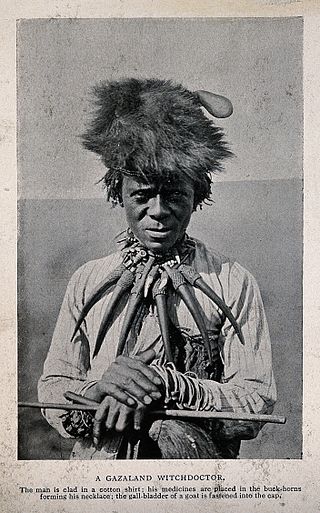
Gazaland is the historical name for the region in southeast Africa, in modern-day Mozambique and Zimbabwe, which extends northward from the Komati River at Delagoa Bay in Mozambique's Maputo Province to the Pungwe River in central Mozambique.
Soshangana Ka Gasa Zikode, born Soshangana Nxumalo, was the Founder and the Monarch of the Gaza Empire, which at the height of its power stretched from the Limpopo river in southern Mozambique up to the Zambezi river in the north. Soshangana ruled over the Gaza state from 1825 until his death in 1858. Soshangana was also known by the name of Manukosi.

Henrique Mitchell de Paiva Cabral Couceiro was a Portuguese soldier, colonial governor, monarchist politician and counter-revolutionary; he was notable for his role during the colonial occupation of Angola and Mozambique and for his dedication to the Monarchist Cause during the period of the First Portuguese Republic through the founding of the Monarchy of the North.

Joaquim Augusto Mouzinho de Albuquerque was a Portuguese cavalry officer. He captured Gungunhana in Chaimite (1895) and was governor-general of Mozambique. He was a grandson of Luís da Silva Mouzinho de Albuquerque.

Luís da Silva Mouzinho de Albuquerque was a Portuguese military officer, engineer, poet, scientist and politician, who distinguished himself during the Liberal Wars and in the conflicts that marked Portugal's history in the first half of the 19th century. He served as the Minister of the Kingdom during the liberal regency of Pedro of Braganza. This was the most prominent post inside the government at that time, which made him the Prime Minister of Portugal in all but name. He was also several times minister and deputy minister during the Constitutional Monarchical period. Among other offices, he served as Chief of the National Mint, captain-general and governor of Madeira, and inspector-general of public works. He was the grandfather of Joaquim Augusto Mouzinho de Albuquerque, a military officer and colonial administrator.
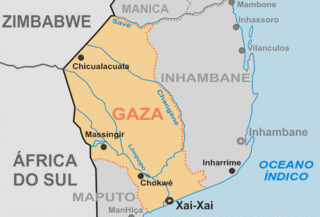
The Gaza Empire (1824–1895) was an African empire established by general Soshangane and was located in southeastern Africa in the area of southern Mozambique and southeastern Zimbabwe. The Gaza Empire, at its height in the 1860s, covered all of Mozambique between the Zambezi and Limpopo rivers, known as Gazaland.

Xai-Xai District is a district of Gaza Province in south-western Mozambique. The administrative center of the district is Chongoene. The district is located in the south of the province, and borders with Chibuto District in the north, Manjacaze District in the east, Bilene Macia District in the southeast, and with Chókwè District in the west. In the south, it is bounded by the Indian Ocean. The area of the district is 1,908 square kilometres (737 sq mi). It has a population of 188,720 as of 2007.

Panda District is a district of Inhambane Province in south-east Mozambique. Its principal town is Panda. The district is located at the northwest of the province and borders with Funhalouro District in the north, Homoine District in the east, Inharrime District in the south, and with Chibuto and Manjacaze Districts of Gaza Province in the west. The area of the district is 6,852 square kilometres (2,646 sq mi). It has a population of 47.946 as of 2007.
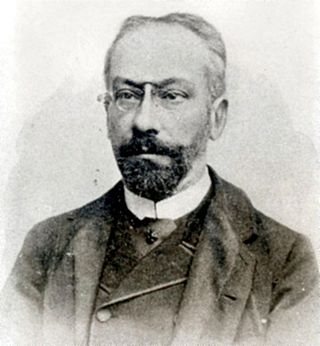
António José Enes, commonly known as António Enes, was a Portuguese politician and writer.
King Mzila Nxumalo, Mzila kaSoshangane Nxumalo, Umzila, Muzila, or Nyamende was the son of Soshangane kaZikode, the founder of the Gaza empire, which at the height of its power stretched from southern Mozambique to the Limpopo River. He defeated his brother Mawewe kaSoshangane in 1861 to ascend to the Gaza throne which he ruled from 1861 to 1885. He was father of King Ngungunyane Nxumalo Gungunhana|Ndungazwe who was deposed by the Portuguese invasion Portuguese Empire.

Chaimite is a village sacred to the Nguni people of the Gaza Empire, currently in Gaza Province, Mozambique. In the area in January 1896, Gungunhana, the last emperor of Gaza, was imprisoned by the Portuguese Empire.

Vice Admiral Guilherme Ivens Ferraz was a Portuguese Navy officer.
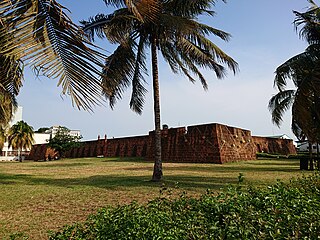
The Fort Nossa Senhora da Conceição of Lourenço Marques, nowadays known as the Maputo Fortress is located at Praça 25 de Junho and represents one of the main historical monuments of the city of Maputo, former Lourenço Marques, in Mozambique.
The Portuguese Campaigns of Pacification and Occupation were a vast set of military operations, conducted in the last decades of the 19th century and in the first two decades of the 20th by the Portuguese Armed Forces in the African overseas provinces of the Portuguese Empire. These campaigns saw action at Chaimite, in Mozambique, where Joaquim Augusto Mouzinho de Albuquerque captured the Vatua king Gungunhana but also at Môngua, in Angola.

The Battle of Macontene of 1897 also known as the Second Battle of Macontene was a military engagement that took place in Mozambique, in the region of Macontene, a plain of the current district of Chibuto, 10 km from that town, in the province of Gaza. Combat took place between expeditionary forces of the Portuguese Army, which included a large number of men recruited both locally as well as in other Portuguese territories in Africa, and the forces of the Vatua commanded by the rebellious Maguiguana.

















